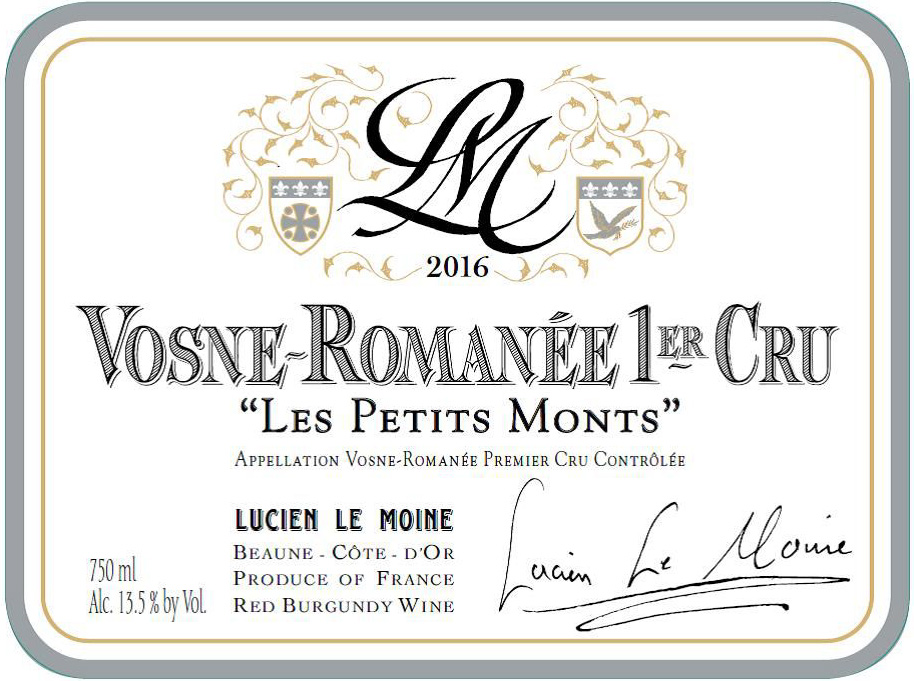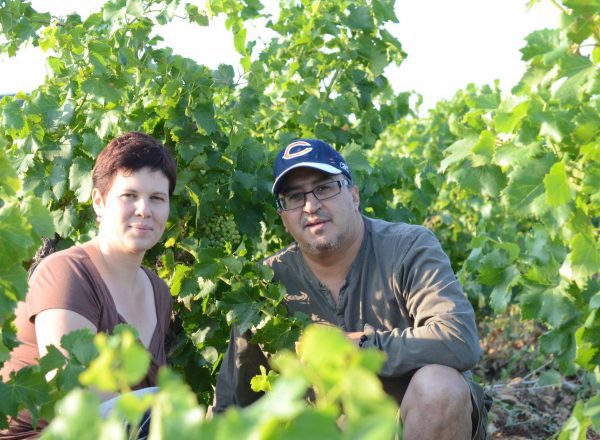Lucien Le Moine
Burgundy, France
In two decades of work, Lucien Le Moine has become one of the most talked about Burgundy producers, making some of the most sought after wines from the region. The approach is extreme – two people, together doing everything by hand, working with a dazzling array of Burgundy’s great terroirs. In the late 1980s, Mounir Saouma’s visit to a Trappist monastery in the Middle East led to a prolonged stay during which he worked in the monastery vineyards and first learned to make wine. He subsequently studied Viticulture and Oenology in Montpellier, followed by six years working in Burgundy, other areas of France, and California. During this time he became fascinated by traditional methods of viticulture, vinification, and aging. In 1999 he decided to push to the extreme all he had seen and experienced, and with his wife Rotem created a small cellar dedicated to the philosophy of making wines of purity and typicity.
Rotem comes from a cheese-making family, and studied agriculture in Dijon, eventually orienting her studies toward wine. After winning a national prize from the French Academy of Agriculture for her study of the Côte d’Or, she participated in numerous harvests in Burgundy and California. The name for Mounir and Rotem’s winery, Lucien Le Moine, is comprised of two references: the Lebanese “Mounir” means light, hence the equivalent French “Lucien”; “Le Moine” translates as “the monk”, and refers to Mounir’s initial wine experiences at the monastery.
From their years spent in Burgundy, Mounir and Rotem knew many superb growers in the region. They devoted themselves to select production of Crus from these growers. They only produce Grands and Premiers Crus, trying each year to have the most beautiful Crus in each village. They revise their selection of Crus every year, depending on the quality of a particular vineyard in a given vintage, but do not produce any more than 100 barrels (2,500 cases), the absolute maximum for Mounir, who feels that any greater production would rob him of the ability to give each his personal touch.
The couple produces one to three barrels from each Cru. This provides the biggest technical challenge, since each barrel needs to be perfect, from selection, through aging, to bottling: there is no blending to cover up even the slightest errors at the end. They work with growers who are scrupulous with their vines, taste the wines very early (right after press), vinify (in the case of whites) or guide vinification in the methods they prefer (emphasizing phenolic ripeness, acid retention, and some employment of whole clusters), and put the wines in their barrels.
All wines are aged entirely on their lees. Gentle batonnage is done a few times a month, less or more depending on the vintage, and the wine is never racked during this process. The cellar is naturally humid and very cool, which pushes malolactic fermentations late into summer. The natural CO2 produced during these long fermentations allows Mounir to use little SO2 (it should be noted it is best to decant all Lucien Le Moine wines as they can have some residual CO2). Once malolactic fermentation is complete, he and Rotem follow each barrel, tasting several times a month. Bottling is done by hand via gravity feed when the wine is ready, always after a full moon (when atmospheric pressure is favorable). No fining, filtration, or addition of sulphur takes place at bottling.
Learn more here.
Wines


Nuits-St-Georges 1er Cru “Les Cailles”
Nuits-St-Georges 1er Cru “Les Cailles”
The Les Cailles is an 18 acre vineyard from which the last several years Lucien Le Moine has produced wines of surprising power that still retain the elegance of Les Cailles. Les Cailles, Mounir Saouma says, is deeper than other Nuits-Saint-Georges 1er Crus, with more body and more tannin. It is dense, and the heat of the vineyard gives a “charred” character to the wine - it becomes clear that this character is the wine’s (and not from oak) when you come to the finish, which is purely fruit. It is clear why some consider it a Grand Cru level vineyard.

Gevrey-Chambertin 1er Cru “Lavaut Saint-Jacques”
Gevrey-Chambertin 1er Cru “Lavaut Saint-Jacques”
Estournelles St Jacques sits just above Lavaut St Jacques, a five acre vineyard at the top of the slope. Mounir Saouma describes this wine by staying it is in character between Les Cazetiers, which is fine and subtle, and Lavaut St Jacques, which is more powerful and tannic. Estournelles St Jacques has a beautiful balance, and a lovely weight that also displays subtlety.

Gevrey-Chambertin 1er Cru “Les Cazetiers”
Gevrey-Chambertin 1er Cru “Les Cazetiers”
Les Cazetiers is a 21 acre vineyard that faces almost due east. Always one of Lucien Le Moine’s exciting wines, it combines fantastic definition and complexity. Mounir Saouma explains that the vines he uses are nearly 100 years old, and there is tremendous subtlety, spiciness and elegance. It is the essence of Gevrey without the body, all finesse.


Nuits-St-Georges 1er Cru “Les Vaucrains”
Nuits-St-Georges 1er Cru “Les Vaucrains”
The commune of Nuits-Saint-Georges is the southernmost commune of the Côte de Nuits, and includes, from a viticultural standpoint, the small adjoining commune of Prémeaux-Prissey. There are 431 acres of vineyards which take this appellation at the village level, of which 29 are in Prémeaux. Of the 1er Cru vineyards, numbering 36, 28 vineyards occupy 248 acres in Nuits-Saint-Georges; the remaining eight, in Prémeaux, cover 104 acres. The Les Vaucrains is a vineyard of 15 acres lying upslope at 260-280 meters in the south part of Prémeaux.


Vosne-Romanée 1er Cru “Les Suchots”
Vosne-Romanée 1er Cru “Les Suchots”
Les Suchots is one of Lucien Le Moine’s finest Crus every year. Mounir says that, like Échézeaux, there is an almost Syrah-like character of licorice and smoke. Les Suchots is a wine with a lot of tannin and less of a classic, delicate Burgundian profile.


Vosne-Romanée 1er Cru “Les Petits Monts”
Vosne-Romanée 1er Cru “Les Petits Monts”
Les Petits Monts is a small, 9 acre vineyard just up-slope from Richebourg. Mounir Saouma says about Les Petits Monts that it is not far from Les Suchots, and on top of Richebourg, with a poor, dry soil. It is in character the opposite of Les Suchots, which is colored and tannic - it is a subtle and very fine wine, which shows little tannin, more floral notes and more of a St-Vivant character.
Reviews
Lucien Le Moine Montrachet Grand Cru 2016 (98 VM)

- “Bright yellow. Very shy aromas of pear, crushed rock and iodine; conveys an almost 2015-like ripeness without any loss of its Montrachet character. This brooding, thick, sappy wine began a bit shy but gained in vibrancy and definition with oxygen, conveying increasing purity. Dominated today by crushed-stone minerality and medicinal herbs, this reserved, utterly seamless wine is barely at the beginning of its evolution. Finishes with remarkable unflagging length. When I remarked to Mounir Saouma that there was something almost obvious and deceptively tastable about this wine, he responded that he still wanted it to develop a bit more volatile acidity before he racks the wine prior to the ‘18 harvest and then returns it to barrel for another couple months before bottling it.”
More on Lucien Le Moine
Lucien Le Moine 2016 Vintage
October 30, 2018 - Click here or on the image below to see more on the 2016 vintage at Lucien Le Moine.
Decanter’s Andrew Jefford Meets the Burgundy and Châteauneuf Specialist Mounir Saouma
December 10, 2018 - Decanter's Andrew Jefford interviews Mounir Sauoma, of Burgundy's Lucien Le Moine and Châteauneuf's Rotem & Mounir Saouma. Jefford cover's Mounir's long career, starting in the late 1990s buying newly fermented…
A Different Take on 2018 in Burgundy
March 4, 2020 - Wine Spectator senior editor and lead taster for Burgundy, Bruce Sanderson, writes of his recent trip to France where he visited boutique negociant Lucien Le Moine to check out the…






